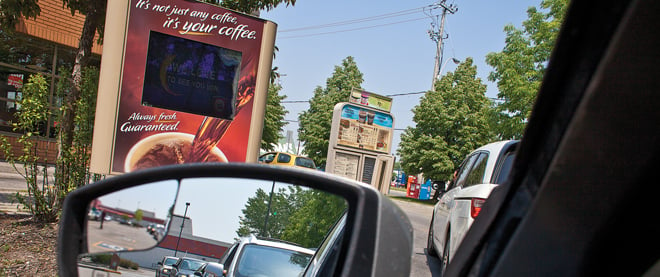Tim Hortons creates double-double lanes to combat ‘drive-through rage’
Coffee chain takes on a fast food dilemma: lineups
Photograph by Andrew Tolson
Share

The never-ending morning drive-through line at Tim Hortons has become a familiar sight, and frustration, in Canada. Caffeine-starved customers have even been known to experience “drive-through rage” at Timmies—in March of this year, a man from Grande Prairie, Alta., cut in line and allegedly brandished a handgun at the riled customer behind him. Drive-throughs are meant to be quicker and more convenient than parking and going inside, but the more popular they are, the slower they get.
Tim Hortons thinks it may have a solution. During a quarterly conference call in May, it announced that it plans to double up single-lane drive-throughs and install second speaker boxes to ease congestion. Those two lanes would eventually merge again at the pickup window. A second cashier will also be added. These so-called “double-order station drive-throughs” have been tested at Tim Hortons in communities across the country, including Fort McMurray, Alta., and Hamilton. (The company even met with Saskatoon city council to discuss the lanes and to ease concerns about drive-through traffic safety in the city.) Alexandra Cygal, a company spokesperson, says it will soon be rolling out the lanes across the country, and that any outlets built from 2012 onwards will have a double-order station drive-through. “By expanding the drive-throughs, we are not only able to bring more cars into the drive-through from parking lots and streets, but we are also able to serve our guests more efficiently, reducing wait times,” she said in a statement.
Tim Hortons is far from the first chain to try to tackle the drive-through dilemma. For years, the restaurant and retail industry has been studying the science of how lines operate, inside and outside stores. McDonald’s was the first to introduce electronic boards that display orders as they’re taken to limit confusion and potential delays. It also experimented in 2006 with using a call centre based in Hawaii to remotely take orders from drive-throughs across the country—cutting costs and freeing store workers to focus on making the food. But that didn’t catch on.
According to QSR, a trade journal for fast-food and casual dining restaurants, there are four factors that make a good drive-through: menu board appearance, speaker clarity, speed and accuracy. But HyperActive Technologies, a Pittsburgh-based restaurant software firm, has found that what matters most for consumers is speed and accuracy. Gad Allon, a professor at Northwestern University in Chicago, co-wrote a study on drive-through customers and what wait times mean for their purchasing power. “Every seven seconds of improvement amounts to an average gain of one per cent of market share [for the company].”
Allon suspects that Tim Hortons’ switch to double drive-through lanes is only a “cosmetic change,” and one that won’t amount to an actual decrease in wait times. “If they’re having people wait in one of two lines to make them look shorter, then it’s superficial and customers will see that.” So if those unhappy customers see a line seven cars long, they’re more likely to drive to the nearest competitor—no matter their price differences. “[Customers] inflate the worth of their time when waiting in line,” says Allon. Asked to assign a value to their time when waiting at drive-throughs, customers said, on average, it was $40 per hour.
After Starbucks opened its first drive-through in 2006, research found that customers who waited in-store were more patient, and measured the worth of their time differently. “You can go and put your things on the table, and they’ll call your name,” explains Allon. “It’s very different, and people don’t feel like they’re waiting. When you’re in a car, it’s a whole different story.” He argues that customers’ patience for lines ultimately boils down to their perception of how much work the cashiers and kitchen staff are doing, and how fast.
Tim Hortons’ two-line solution would work better if coffee-only customers were filtered through one line, and longer orders through another, says Allon. But the plan is mostly to shuttle traffic away from city streets. Perhaps to quell queue rage, it should instead be expanding its parking lots.